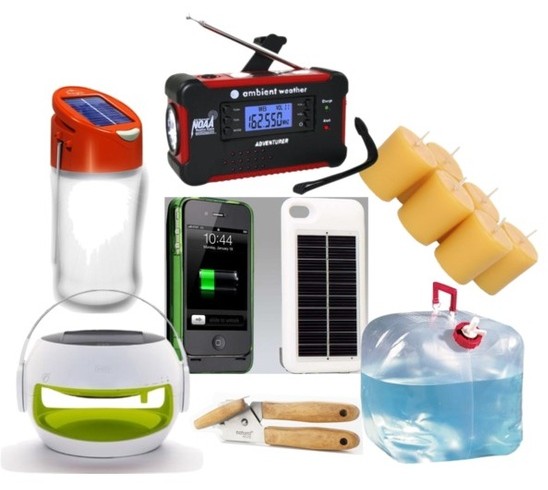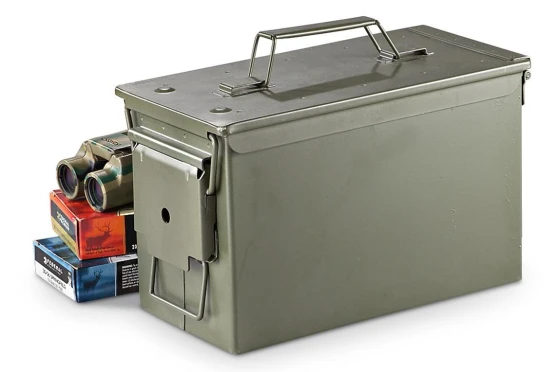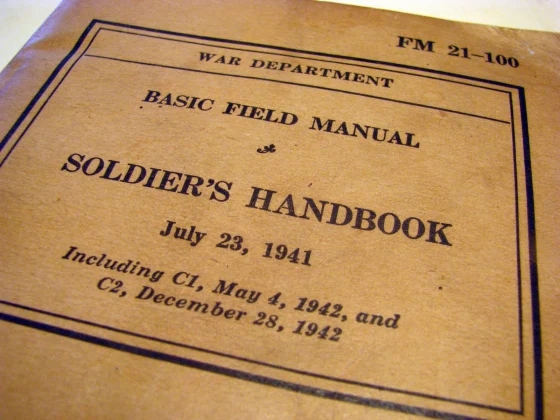Contents:
- General Thoughts
- Types of Generators
- Generator Fuels
- Choosing a Generator
- Generator Fuel and Storage
- Generator Maintenance, and Repairs
- Generator Safety & Security
- Generator Accoutrements
General Thoughts:
On an average day 97,000 utility customers are without power.
You can have a professional electrician wire your generator so that it will run your entire house, or at least a part of it.
If you are not going to have your generator wired directly into your home, make sure that you have the appropriate cables to run your refrigerator-freezer.
back to top
Types of Generators:
Portable Generators:
A portable generator is one that is on wheels and that is not permanently connected to your home’s electrical system. The biggest benefit of a portable generator is that it is… portable. You can use it to power a few critical appliances like a refrigerator, furnace, microwave, TV and lights when you have a power failure in your home, or take it with you to the construction jobsite or the weekend campsite.
Good size portable generator: 5500 watts. Enough to power a few critical appliances like a refrigerator, furnace, microwave, TV and some lights. You can’t run a whole-house air conditioner and an electric water heater at the same time with 5,500 watts, but a generator this size will get you by until the power comes back on.
A good quality 5,500-watt generator starts at around $700 US.
Portable generators are often noisy and require frequent refueling.
A 5500 watt generator will run about eight hours on five gallons of gasoline.
Standby Generators:
Standby generator is permanently connected to your home’s electrical system and goes on automatically when the power goes out, providing seamless power. Standby generators can run on propane or natural gas, eliminating the need to monitor fuel. And they are quieter.
You can buy one large enough to power everything in your house, or you can buy a smaller unit and choose the most critical circuits to power.
Standby generators start at about $1800 plus installation. They will have to be installed by a professional.
The difference in cost between a portable generator and a standby unit may not be as great as you think. A portable unit requires either expensive extension cords or a transfer switch. Standby units can run on less expensive natural gas, which will save you money n the long run.
back to top
Generator Fuels:
Gasoline:
Gasoline is handy, but it’s not without problems. Storing enough gasoline to get you through a several-day power outage requires constant vigilance. First you have to buy several five-gallon gas containers and find a safe place to store them. Then you have to add stabilizer and ideally replace the gas after several months to make sure it is still fresh when you need it.
Diesel:
Although there are a few portable diesel-powered generators on the market, the majority run on gasoline and propane.
A pro to using a diesel powered generator is that diesel fuel is much easier to store for long term, although it is still recommended that you use a diesel fuel stabilizer.
A con to diesel powered generators is that they can be difficult to start when they are very cold.
Most diesel powered generators are larger, standby types intended to power buildings, such as hospitals and grocery stores (think refrigeration) during power outages.
Liquid Propane (LP):
Propane is easier than gasoline. When it comes to portable generator and ease of use, liquid propane (LP) beats gasoline. As discussed above, there are challenges to storing gasoline and gasoline powered generators
Propane-powered generators solve these problems. You can store and use liquid propane (LP) indefinitely (it doesn’t go bad). Refueling is simple and safe. You simply replace the empty propane tank with a full one. Another benefit is that you don’t have to worry about the carburetor on your generator getting gunned up with old gasoline.
There are several converter kits on the market that will allow you to run your normally gasoline powered generator on LP instead.
Natural Gas:
Coming soon.
back to top
Choosing a Generator:
-
Link to Home Generator Guide
-
Electropedia’s Generators: Description and Applications
-
Briggs & Stratton’s Choosing A Portable Generator
-
Briggs & Stratton’s Portable Generator Buying Guide
-
FamilyHandyman.com’s Choosing The Best Power Generator
-
PlanetGenerators.com’s Portable Generator Reviews & Buying Guides
How Many Watts?:
If you really want to know what size generator you need to power everything you want, then the only way is to add up the wattage of all of your lights, appliances, and motors that you intend to power simultaneously.
 Generator manufacturers and retailers have charts and cheat-sheets to you can refer to that list the average wattage used for various appliances and motors. If you want to be precise you can check the nameplates on the appliances you want to power. If wattage is not listed you can derive it by multiplying volts by amps. Example: If the plate lists 2.5 amps at 120 volts, multiply the two to get 300 watts.
Generator manufacturers and retailers have charts and cheat-sheets to you can refer to that list the average wattage used for various appliances and motors. If you want to be precise you can check the nameplates on the appliances you want to power. If wattage is not listed you can derive it by multiplying volts by amps. Example: If the plate lists 2.5 amps at 120 volts, multiply the two to get 300 watts.
There is one caveat. Motors require an extra surge of electricity to get started, and you have to factor this into the equation. Add of the wattage of everything you want to run. Then determine the largest motor (such as the furnace)and multiply the wattage requirement by 2 to get the approximate start-up wattage required. Then add that number to the total.
Buy a generator that you can get serviced locally.
You may find a great deal on a generator by shopping online, but what will you do f you can’t get it servced locally? It may be worth spending a little extra to buy from a local dealer. Parts will be available, and the dealer wll be familiar with maintenance and repair procedures for your model. Before you buy a generator, make sue that ther is someone nearby wo can provide parts and service.
back to top
Generator and Fuel Storage:
Generator Storage:
Always check the oil level before you run your generator. Change the oil as recommended by the manufacturer.
You will want to run your generator at least once a month for about fifteen minutes to let it completely warm up to its normal operating temperature. If possible place an electrical load on the generator.
If you have a gasoline powered generator (as opposed to a liquid propane (LP) or natural gas powered) and it has a fuel shut-off valve between the carburetor and the fuel tank then you will want to use the shut-off valve to starve the carburetor to shut down the engine. This way the carburetor will be stored without any fuel in to spoil and gum up the carburetor. Also, store the generator with the carburetor’s choke extended. That should guarantee that there is no residual fuel in the choke to gum up.
If you store your generator with fuel in the fuel tank then you will want to make sure that the fuel has been treated with Seafoam or Sta-Bil brand fuel stabilizer. Do not store your generator with fuel that has not been stabilized. If the fuel in the tank gets older than six months it is recommended that you drain it and replace the old fuel with new, stabilized fuel. Go ahead and use the old fuel in your lawn care equipment.
Fuel Storage:
If you have a gasoline powered generator then you will need to have plenty of gasoline to run it. You can store the fuel in five-gallon fuel tanks, however a full five-gallon fuel tank weighs 30-pounds. If you or anyone else that might be responsible for refueling your generator would have trouble lifting and pouring from a 30-pound can then you might consider storing your fuel in lighter 2 1/2 gallon fuel cans.
Having plenty of full fuel cans available is prudent, but you will need to add fuel stabilizer such as Seafoam or Sta-Bil to extend the shelf life of the fuel. Even with the stored fuel stabilized, every six month you will want to burn it in your vehicle or yard equipment and refill the cans wth fresh, stabilized fuel. Figure out a way to organize your fuel so that you will know when it is due to be replaced.
If possible, store your fuel in a locked shed away from your residence. Storing fuel in your garage or residence is VERY dangerous, and over storing over certain amounts is illegal in many areas.
Note: Ethanol (alcohol) is present in most regular gasoline and it cause the gas to break down faster. Premium fuel does not have ethanol in it, and while more expensive than regular, it will remain stable longer than regular gasoline.
back to top
Generator Operation, Maintenance, and Repairs:
-
Savannah Arsenal’s Guide to Fuel Storage and Transportation
-
PlanetGenerators.com’s Tricks & Cheats
-
FamilyHandyman.com’s Generator Maintenance Tips
-
Briggs & Stratton’s Carburetor Trouble Shooting Guide PDF
-
Briggs & Stratton’s Checking and Changing Oil In Small Engines
-
Briggs & Stratton’s Small Engine Tune Up
-
Briggs & Stratton’s How To Clean A Carburetor
-
Briggs & Stratton’s Portable Generator Safety & Usage Tips
Most Four-Stroke Engine Problems Fall Into One Of These Categories:
Engine Won’t Start:
- Fuel line problems.
- Carburetor problems.
- Ignition problems.
- Compression problems.
Engine Runs Poorly:
- Engine smokes.
- Engine overheats.
- Engine knocks.
- Engine misses under load.
Engine Problem Diagnosis:
Engine Smokes:
- Blue or white smoke = engine burning oil.
- Engine producing black smoke = mixture is too rich. Adjust the mixture on the carburetor.
- Air filter may be plugged.
Engine Overheats:
- Engine is dirty. Especially important with air-cooled engines. Clean the engine.
- Oil level is low. Add the appropriate amount of oil.
- Shrouds or cooling fins are missing on an air-cooled engine. Repair or replace.
- Fuel mixture is too lean. Adjust the mixture.
- The fuel tank vent, fuel tank screen, or fuel filter may be plugged.
Engine Knocks:
- Combustion chamber contains excess carbon. Pour small sips of Seafoam into the carburetor while the engine is running. You will know that it is cleaning the engine when it is producing thick, white smoky exhaust.
- Sparkplug wire is faulty. Replace the wire(s).
Sparkplug Misses Under Load:
- Sparkplug is fouled.
- Sparkplug is faulty or the gap is incorrect.
- Carburator is set incorrectly.
- Valve springs are weak.
- Valve clearance is set incorrectly.
back to top
Generator Safety & Security:
Make sure that your running generator is far enough from the house that carbon-monoxide exhaust will not enter the house. It is a silent killer.
If possible, only run the generator in the backyard or somewhere with some privacy. The noise may or may not draw some attention, but if anyone can see it they will surely try to take it. While running it during the day some of the noise may be covered by local traffic. At night when most everyone is sleeping and there are no cars running and no home AC units running, you generator is going to be the loudest thing in the world and everyone is going to know that you have one. Make sure to store it in a secure area so that it is not stolen.
back to top
Generator Accoutrements:
Transfer Switch:
While you can use extension cords from your portable to power any device with a plug, anything that is directly connected to your home’s wiring, such as a well pump, furnace, and electric water heater, requires a transfer switch.
A manual transfer switch is essentially a small circuit breaker box that you mount next to your main electrical panel. You match the capacity of the transfer switch to the wattage of your generator. then you choose which circuits to connect to the transfer switch.
A transfer switch is the only safe way to connect your generator to house wiring because it requires you to disconnect the house wiring from the incoming power lines at the same time you switch to generator power. The prevents the possibility of “backfeeding” generated power into the power lines, which creates a potentially lethal hazard for power line workers.
Installing a manual transfer switch is an advanced electrical project. It should only be accomplished by a qualified electrician.
Power Cables and Extension Cords:
Coming soon.
Portable Air Conditioners and Fans:
I have suffered through a 24 hour weather related blackout during the hot season. The house gets hot very fast. Unless you invest in an extremely large and expensive generator system, you are not going to have central air-conditioning. A small window-unit AC unit is a wise investment. It can be stored out-of-the-way in the garage, quickly installed in the master bedroom when needed, and run off the generator to cool the sleeping area during the hot part of the day and prior to bedtime. Only try to cool the sleeping areas. Use box fans to circulate the cool air through those areas.
Rechargeable Batteries and LED Lighting::
When you are running your generator be sure to plug in and charge any rechargable batteries that you will need when the generator is not in use. You charge 12-volt deep-cycle auto/marine batteries and use them to power all sorts of low-amperage LED type lights when the generator is off. Check out your local auto parts and boating stores to check out all of the cool-running, power sipping LED lights that are made for boats and campers.
Fuel Cans:
back to top
x
Buy Gas When You Buy The Generator:
A 5500 watt generator will run about eight hous on five gallons of gasolne, so fuel management is critical if you want to be prepared for an extended power outage. You may have to run your generator for short periods of time and then coast in items like refrigerators.
The generator itself should be run dry for stoage or fille dwith stabilzed fuel. That fuel should be replaced every sx moths as well.









































I am basically wanting to know just what everyone thinks regarding the portable generator!
LikeLike